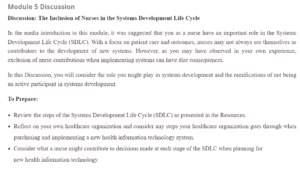Module 5 Discussion
The Inclusion of Nurses in the Systems Development Life Cycle
As important frontline healthcare workers, nurses should be included in the process of adopting a health information technology (HIT) system if any level of success is desired. The exclusion of nurses in such a process may have several ramifications that may culminate in the ultimate failure of the project. Multiple threats are inherent in a HIT project that does not include nurses.
Failure to involve nurses during the planning stage of a HIT project can result in project failure due to unprecedented budget overruns. Excluding nurses during the early phase of such a project limits the ability to accurately define the scope of the project, including the potential need for intensive HIT training (Weckman & Janzen, 2009). Imaginably, unanticipated training needs may present hidden costs to the HIT implementation process that may stretch the current budget besides extending the project timeline.
Additionally, excluding nurses from such a project may result in the adoption of a redundant system. As key members of the clinical staff, the participation of nurses in the HIT adoption effort ensures that the HIT system has a range of features and capabilities, including all the relevant documentation needs and data sets (Qin et al., 2017). Therefore, failure to involve nurses may lead to adopting a system filled with redundancies and failing to address patient care gaps.
Similarly, failure to involve nurses when implementing the project may result in the deterioration of organizational quality outcomes. These negative outcomes include reduced quality of patient care, increased patient safety concerns, and poor patient outcomes, such as reduced patient satisfaction. These consequences may result due to disturbances in the normal workflow and a reduction of nurse engagement because of user frustrations, such as navigation challenges (Byrne, 2016). This makes nurse involvement an integral requirement in the HIT implementation process.
I participated in the acquisition of an EHR system in my previous role as a nurse at a dialysis center. Although I was not involved in the entire implementation process, I was part of a team of nurses deployed to trial the two candidate systems, AdvancedMD and eClinicalWorks, and provide feedback to the implementation committee. Our feedback regarding the relative complexity of the eClinicalWorks user interface was key in the eventual adoption of the AdvancedMD system.
References
Byrne, M. D. (2016). Nurse Engagement in Health Care Information Technology Policy. Journal
of PeriAnesthesia Nursing, 31(1), 99-102.
Qin, Y., Zhou, R., Wu, Q., Huang, X., Chen, X., Wang, W., … & Bai, C. (2017). The effect of nursing participation in the design of a critical care information system: a case study in a Chinese hospital. BMC Medical Informatics and Decision Making, 17(1), 165.
Weckman, H., & Janzen, S. (2009). The critical nature of early nursing involvement for introducing new technologies. OJIN: The Online Journal of Issues in Nursing, 14(2).
ORDER A PLAGIARISM-FREE PAPER HERE
We’ll write everything from scratch
Question 
Module 5 Discussion
Discussion: The Inclusion of Nurses in the Systems Development Life Cycle
In the media introduction to this module, it was suggested that you as a nurse have an important role in the Systems Development Life Cycle (SDLC). With a focus on patient care and outcomes, nurses may not always see themselves as contributors to the development of new systems. However, as you may have observed in your own experience, exclusion of nurse contributions when implementing systems can have dire consequences.
In this Discussion, you will consider the role you might play in systems development and the ramifications of not being an active participant in systems development.
To Prepare:

Module 5 Discussion
- Review the steps of the Systems Development Life Cycle (SDLC) as presented in the Resources.
- Reflect on your own healthcare organization and consider any steps your healthcare organization goes through when purchasing and implementing a new health information technology system.
- Consider what a nurse might contribute to decisions made at each stage of the SDLC when planning for
new health information technology.
Post a description of what you believe to be the consequences of a healthcare organization not involving nurses in each stage of the SDLC when purchasing and implementing a new health information technology system. Provide specific examples of potential issues at each stage of the SDLC and explain how the inclusion of nurses may help address these issues. Then, explain whether you had any input in the selection and planning of new health information technology systems in your nursing practice or healthcare organization and explain potential impacts of being included or not in the decision-making process. Be specific and provide examples.
